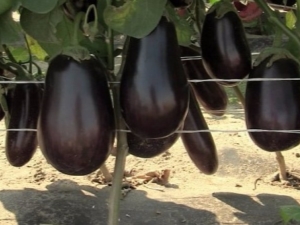How to feed the eggplant after planting in the greenhouse?

Most gardeners grow eggplants in their summer cottages.Moreover, this vegetable is often planted in greenhouses (it is best to grow eggplants in polycarbonate constructions). Today we will talk about how you can feed him in such conditions.
How to feed vegetables?
Eggplants should be fed throughout their development in the greenhouse. In this case, the first feeding should be done within 10-14 days after planting. Processing is recommended to be carried out with a solution with bird droppings or mullein.
In such a composition must be added and superphosphate. Instead, it is permissible to use wood ash. You can also take simple herbal infusions. Such fertilizers are considered organic, namely, they are most useful for vegetables in the initial stages of their development.
Before flowering, you should also make some feeding. Moreover, they do it immediately with complex fertilizers with mineral elements. This contributes to the normal and full development of plants.
After the appearance of the first leaf, young bushes can be treated with special chemicals (“Growth”, “Zircon”). These funds are special catalysts for the growth of such plants.
Instead, they can be treated with a solution with the addition of dry yeast. To prepare such a composition, it is necessary to dilute this component (one gram) in pure water (three liters). The resulting liquid is infused for one day. Then it is carefully treated bushes, it should be done only 1-2 times during the growth of eggplant.
The following dressing should be carried out at the moment when the vegetable begins to bloom. For this, seedlings are watered with a special compound with ammonium nitrate (10 grams), potassium chloride (15 grams), and superphosphate (50 grams). All these components are diluted in 10 liters of clean and warm water. If you do not have ammonium nitrate, you can use wood ash.
For the second feeding, some gardeners advise the use of substances containing potassium and nitrogen. After all, these elements are important for the good development of eggplants in this period. Fed eggplant bushes and during their fruiting (the third feeding). To do this, it is necessary to prepare a solution with a high content of potassium and nitrogen components.
Do not forget that after each feeding, the plants must be watered with clean and pre-heated water. This should be done so that the fertilizers just applied will be absorbed faster in the soil.
During the fruiting period, seedlings should be fed for 2-3 weeks. Moreover, the portion of urea in fertilizers should be gradually increased. Its maximum dose should be at least 25 grams per square meter of land. It is acceptable to use special chemicals during the fruiting period.
During flowering and fruiting, many gardeners use an aqueous mixture as a top dressing, it contains urea, superphosphate and potassium sulfate. Also, some use water infusion with nettle. This composition contains elements of nitrogen, calcium and potassium. Before use, the infusion is recommended to be diluted slightly with water. For processing uses one liter of this broth for one bush.
Some gardeners are advised to feed the eggplant bushes drug "Gumi-Omi." It is a powdery substance. This tool refers to organo-mineral. As part of the drug has chicken droppings (in the form of compost). Also "Gumi-Omi" contains a large amount of phosphorus, nitrogen, calcium and various trace elements (sodium, boron, copper).
Before planting eggplants in the greenhouse, the soil in it is fed with various substances. So, dolomite flour, wood shredded sawdust, potassium sulphate, acid peat must be introduced into it (acid addition is not necessary). Also, many gardeners advise to make manure or a mass of humus.
If you notice that the eggplant bushes have drastically slowed down in their growth or development, then you need to use specialized tools to restore the plants. The most effective of them are “Ideal”, “Signor”, “Agricola Forte”.
Required items
Most gardeners separately note some necessary supplements for such plants:
- with phosphorus;
- with potassium;
- fertilizers containing trace elements;
- top dressing with nitrogen.
Phosphorus
It is this substance promotes successful fruiting and flowering. Top dressing with phosphorus accelerates the growth and development of the entire root system of plants. If you notice that the leaf blades on your plants are directed slightly upwards, then this indicates a severe lack of phosphorus compounds.
Particularly badly needed phosphorus fertilizing young, still fragile seedlings during the formation of buds. But at the same time, only adults and strong plants can fully assimilate this element, therefore at the initial stages of development it is recommended to bring phosphorus together with foliar elements.
Potassium
Potassium fertilizers allow plants to accumulate the amount of carbohydrates they need. And this allows you to significantly increase the number of fruits and their quality. In addition, potash compounds can protect vegetables from many diseases.
If you notice that the leaves of eggplants begin to curl inwards, then this indicates that they lack exactly potassium. A brown bloom gradually forms along their edges. At the final stages, the leaf plates dry out completely.
Trace elements
Due to the lack of many microelements (iron, manganese, magnesium), eggplants often suffer from chlorosis and grow poorly. But not only these elements are necessary for the normal growth and development of young seedlings. Mandatory components for such vegetable crops are molybdenum, copper and boron. Remember that all trace elements are best absorbed with foliar feeding. Therefore, we can not forget about them.
Nitrogen
Nitrogen allows plants to quickly grow their green mass. It also contributes to the successful flow of photosynthesis. Due to the lack of this chemical element, the growth of a plant can slow down dramatically. In this case, the leaves will begin to dramatically brighten, and then they will completely acquire a yellow color.
With such a shortage, this element should be urgently introduced. Otherwise, the leaves just fall off, and the seedlings will soon die. But remember that excess portions of nitrogen also will not lead to a good result. Because of this, eggplant immunity will decrease significantly.
If you do not want to constantly add fertilizer for eggplants, then you can pour a special AVA complex fertilizer (1/3 teaspoon) into each well before planting. Then once every ten days the plants are watered with infusion of fermented grass (one liter per bucket of water). Such care is enough for the normal development of vegetables.
Leaven
Often eggplants are fed not only with dry yeast solutions, but also with sourdoughs with them. Such substances act as strong growth stimulants for young, still fragile seedlings. Also, these natural sourdoughs are able to saturate the soil with special beneficial microorganisms. They can contribute to the rapid development of the root system and the growth of green mass.
For the preparation of a universal yeast-based yeast base, you must prepare the necessary ingredients:
- sugar (half a glass);
- wood ash (two glasses);
- brown bread crust;
- fresh yeast (0.3 kilograms);
- hydrated lime (one glass);
- chicken dung or manure (one liter);
- mowed grass (one kilogram);
All these components are completely filled with water. Moreover, it should be preheated in advance. The resulting liquid is allowed to infuse for one week. After that, the solution is diluted with water (one glass of mass accounts for ten liters of pure water).Eggplants are fertilized with this sourdough every week.
Possible difficulties
If you decide to plant and grow eggplants in the greenhouse, You may encounter some problems.
- Twisting of leaf blades. This is due to the appearance of pests, too much moisture or a lack of sunlight.
- Weak development of shoots after transplanting plants. In this case, eggplant is to feed. After all, such a violation occurs due to the weakening of the root system of the vegetable.
- The plant ceases to bear fruit, but at the same time it blossoms. This phenomenon is due to the fact that seedlings do not receive full pollination.
- The difficult formation of ovaries on the bushes. This phenomenon may be due to excess fertilizers containing nitrogen. It can also happen due to the lack of timely pruning.
- Falling ovaries. Plants suffer from this due to excessive moisture.
- The appearance of yellowed leaves. Leaf plates acquire such color after improper fertilization or improper watering.
- The formation of colored spots on the leaves. This phenomenon is associated with excessive exposure to ultraviolet rays on seedlings.
Do not forget that for the normal cultivation of eggplants in the greenhouse they should be timely fed with special fertilizers. In addition, the soil around the seedlings periodically need to loosen.
Also do not forget to carry out preventive measures against parasitic insects that can harm the vegetable. If you strictly follow all these rules, you can get a high yield and collect from one bush to eight kilograms of fruit.
On the care of eggplants after planting in the greenhouse, see below.






































